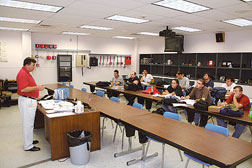
Photo:E. Michael Powers/ENR Apprentice in St. Louis electrical workers' union program will earn college credit.
|
As the construction industry struggles to produce more skilled craft workers, apprenticeship programs are seeking new recognition for the high levels of technical proficiency they provide. That recognition is coming in the form of college credit, and it is creating a short path from training program completion to a two-year diploma from allied schools. In some cases, unions are even eliminating the middleman by having apprenticeship programs certified as accredited post-secondary degree granting institutions.
“For a long time our trustees have been discussing the future of apprenticeship, says Mike Metz, administrator of the Finishing Trades Institute (FTI), an arm of the International Union of Painters and Allied Trades. “In our opinion, it is to link it with the higher education system.”
|
FTI has been running a program with Marshall Community and Technical College, Huntington, W.Va., to award college credits toward a two-year associate degree for workers in the apprenticeship program. But Metz would like to take that a step further. “I would like to see our apprenticeship program move from [oversight] by the U.S. Labor Dept. to the Education Dept.,” he says.
“We believe that third-party accreditation will allow our training centers to reach a standard of excellence well beyond the minimal performance standards currently required by [Labor Dept.] standards of apprenticeship,” says painters’ union General President James A. Williams.
FTI aims to become an accredited college able to award its own credits and bestow degrees. It is seeking national accreditation through the Council on Occupational Education, an Atlanta group that reviews occupational education programs.

Photo: E. Michael Powers/ENR Accrediting apprenticeship programs to award college credits and degrees could be a major recruiting boon as worker numbers drop.
|
Most apprenticeship programs that partner to offer credit must have curricula reviewed by another organization, the American Council on Education, Washington, D.C. But the student or program must find schools willing to accept the credits, a potentially difficult and expensive process, says Metz.
Also, apprentices rarely receive credit for all of their work, mainly because there are limits to the number of transfer credits a college can count toward a degree. “When we weighed the current system against this cutting-edge approach, we decided that there are significant long-term benefits,” Metz says. The FTI program is 18 months from accreditation. If successful, union members could receive up to 90 college credits from their apprenticeship that they can transfer to another college or use to complete an associate degree by taking two on-line classes, says Williams.
 "Accreditation will allow training to reach a standard of excellence." "Accreditation will allow training to reach a standard of excellence." — James A. Williams,
General President, International Union of Painters and Allied Trades |
Steve Brown, Marshall College associate dean and director of campus programs, sees the offering of a degree as a powerful recruiting tool as trades compete for young workers. “Parents will buy into their children entering apprenticeship programs if they see a degree associated with them,” he says.
But Brown sees limits in the system. “A lot of these programs have more credit than we are allowed to give them,” he says. The more outside coursework that craft workers have to complete, the less likely they are to finish the degree, Brown contends. “People with good paying jobs don’t see the benefit yet of cutting down on work to take classes,” he says.
Brown hopes more union leaders will seek degrees to break the ice. “As the leaders start earning their degrees and showing the membership how they did it, I think more members will take advantage of the opportunities,” he says.
West Virginia has further developed its technical degree programs, first mandated in 1987 as an alternative to liberal arts, to make them more appealing. “In the past, an associate degree in applied science was considered a terminal degree,” says Brown. “We have created another degree, a bachelor’s of applied science, which will allow workers to then get a master’s degree.”
Williams says the painters’ apprentice curriculum also is being reviewed by Empire State College, a Saratoga Springs, N.Y., institution that is part of the state university system. The school, which has been allied with a local electrical union apprenticeship program since 1977, requires all apprentices to complete an associate degree before becoming a journeyman.
Paid to Learn
The Empire State program is highly successful, with about 85% of students graduating, says Michael Merrill, dean of the college’s Harry Van Arsdale Jr. Center for Labor Studies. Local contractors fund the program jointly with the union and students are paid for their time in Empire State’s classrooms just as if they were on a jobsite. “The contractors renew the contract year after year and continue to fund it, showing a clear indication that they support it,” Merrill says.
Merrill sees the growing popularity of union-college partnerships as a sign of changing times. When craft workers go to college, “it isn’t just about learning things they don’t know. It’s also about colleges learning to recognize the skills that they have,” he says. “Colleges are starting to see the intelligence it takes to be a construction worker. There is no such thing as an unskilled worker. There is just a worker without a degree.”
Merrill says that while parents are attracted to children gaining a college education as well as a skilled trade, young recruits are drawn to the program by the promise of a good living in the future and a decent wage while being educated.
The St. Louis Area Electricians Joint Apprenticeship and Training Program, an alliance between electrical workers’ union Local 1 and the St. Louis chapter of the National Electrical Contractors Association, is also jumping into the accreditation game. The St. Louis training center has alliances with seven local colleges to issue credits for apprenticeship training, but participation in the program now is meager. “Only 10% to 15% of our apprentices participate in the college credit program,” says apprenticeship director Dennis Gralike. “I think we would have more if the training center were able to issue the credits.”
While the center would not have resources to offer all classes needed for a two-year degree, it would be able to provide most credits and partner with local colleges to provide missing general studies courses, he says. “I think it’s going to be a tremendous benefit for me to be able to tell high school students that I am a college recruiter,” adds Gralike.
The St. Louis training center has an alumnus who can attest to apprenticeship’s educational merits, Marion Hayes, who now owns and runs locally based BRK Electrical Contractors. He entered the training program after finishing a B.S. in electrical engineering and an M.S. in construction management from Washington University in St. Louis. He finished his apprenticeship in 1995.

Hayes
|
“In an apprenticeship, you don’t do the high-level math but you put the theories to use. What I do now, it’s putting the theory to use,” says Hayes. “Construction apprenticeship programs should not be disparaged. Most high school teachers want students to go to college, even if it means going to a two-year school before a four-year one. But teachers don’t think in terms of apprenticeship programs. They have no idea of the benefits of those types of skills.”
Hayes says an apprenticeship actually evaluates students’ work force viability. “Employers are evaluating [apprentices’] performance at the same time as the instructors,” he says. “The name of the game is to have a marketable skill. So many service jobs are going overseas. The unique thing about our trade is that there will always be a need here for workers. You can’t build a new stadium in China and ship it here.”

|

Renderings:Local 150 Operating Engineers' Union With a $50-million training center soon to open, Chicago�s operating engineers� union now seeks apprenticeship college credit.
|
By this time next year, the third-largest local construction union in the country also hopes to offer college credits to apprentices through a new training facility under construction in Wilmington, Ill. Sited on 300 acres 60 miles southeast of Chicago, the 341,000-sq-ft facility will house an auditorium, climate-controlled arena, equipment repair shop, material-testing laboratory, outdoor training space, cafeteria and classrooms. “It’s like a small university,” says William E. Dugan, business manager of operating engineers’ union Local 150 in Chicago. The $50-million project is set for completion in September 2007.
Hot Issue
“Everybody agrees training is the issue,” says Jeffrey Vincent, executive director for the operating engineers’ national training fund in Washington, D.C. He likens union-college partnering to the GI Bill, which sent millions of World War II veterans to school and sparked productivity gains in the postwar economy. “It would not surprise me if we see the same kinds of things coming out of these efforts,” he says.
Under the roof of the 90,000-sq-ft equipment arena, equipment trainers will be able to demonstrate paving operations on the coldest days of winter “for the first time in the history of our local,” says Robert Paddock, acting coordinator for Local 150’s apprenticeship program. Aspiring mechanics will learn how to inspect the undercarriage of a crawler tractor inside a 200-seat auditorium wired up with high-speed Internet and other amenities.
The local union is not content with having what it calls one the most modern heavy-equipment training centers in the country. It also is in talks with Chicago-area community colleges to offer credit toward an associate degree in applied science by the time the center opens. Equipment operators, mechanics, material technicians and other tradespeople would be able to take general coursework at colleges to earn their degree after finishing a four-year apprenticeship. Others could go on to higher degrees.
Vincent says these programs are expensive and a tough sell for signatory contractors. But “given where we’re at with the vast capital intensity of operating heavy equipment, the investment on the skill training side is obviously going to have to be commensurate,” he adds.
Local 150 officials often say that their future lies in the new training facility. “We expect our union to grow, we expect our membership to grow and we are ready for it,” says Paddock.
 Related Links:
Related Links: 